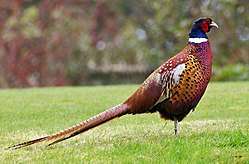Phasianinae
| Phasianinae | |
|---|---|
 | |
| Mongolian ringneck-type common pheasant (Phasianus colchicus) cock | |
| Scientific classification | |
| Kingdom: | Animalia |
| Phylum: | Chordata |
| Class: | Aves |
| Order: | Galliformes |
| Family: | Phasianidae |
| Subfamily: | Phasianinae Horsfield, 1821 |
| Type species | |
| Phasianus colchicus | |
| Genera | |
The Phasianinae (Horsfield, 1821) are a subfamily of the pheasant family (Phasianidae) of landfowl, the order Galliformes. The subfamily includes pheasants, tragopans, junglefowl, peafowl, and other similar birds.[1] Although this subfamily was considered monophyletic and separated from the partridges, francolins, and Old World quails (Perdicinae) till the early 1990s,[1][2] molecular phylogenies have shown that this two subfamilies actually constitute only one lineage. For example, some partridges (genus Perdix) are more closely affiliated to pheasants, whereas Old World quails and partridges from the genus Alectoris are closer to junglefowls.[3][4]
Phasianinae are characterised by strong sexual dimorphism, males being highly ornate with bright colours and adornments such as wattles and long tails. Males are usually larger than females and have longer tails. Males play no part in rearing the young. They typically eat seeds and some insects.
Species in taxonomic order
This list is ordered to show presumed relationships between species.
- Genus Ithaginis
- Blood pheasant, Ithaginis cruentus
- Genus Tragopan
- Western tragopan, Tragopan melanocephalus
- Satyr tragopan, Tragopan satyra
- Blyth's tragopan, Tragopan blythii
- Temminck's tragopan, Tragopan temminckii
- Cabot's tragopan, Tragopan caboti
- Genus Pucrasia
- Koklass pheasant, Pucrasia macrolopha
- Genus Lophophorus, monals
- Himalayan monal, Lophophorus impejanus
- Sclater's monal, Lophophorus sclateri
- Chinese monal, Lophophorus lhuysii
- Genus Gallus, junglefowl and chickens
- Red junglefowl, Gallus gallus
- Domestic chicken, G. g. domesticus
- Grey junglefowl, Gallus sonneratii
- Sri Lanka junglefowl, Gallus lafayetii
- Green junglefowl, Gallus varius
- Red junglefowl, Gallus gallus
- Genus Lophura, gallopheasants
- Kalij pheasant, (L. leucomelanos)
- White-crested kalij pheasant, (L. l. hamiltoni)
- Nepal kalij pheasant, (L. l. leucomelanos)
- Black-backed kalij pheasant, (L. l. melanota)
- Black kalij pheasant, (L. l. moffitti)
- Black-breasted kalij pheasant, (L. l. lathami)
- William's kalij pheasant, (L. l. williamsi)
- Oates' kalij pheasant, (L. l. oatesi)
- Crawfurd's kalij pheasant, (L. l. crawfurdi)
- Lineated kalij pheasant, (L. l. lineata)
- Silver pheasant, (L. nycthemera)
- Imperial pheasant, Lophura imperialis
- Edward's pheasant, Lophura edwardsi
- Vietnamese pheasant, Lophura edwardsi var. formerly Lophura hatinhensis
- Swinhoe's pheasant, Lophura swinhoii
- Hoogerwerf's pheasant, Lophura hoogerwerfi
- Salvadori's pheasant, Lophura inornata
- Crestless fireback, Lophura erythrophthalma
- Malayan crestless fireback, (L. e. erythrophthalma)
- Bornean crestless fireback, (L. e. pyronota)
- Crested fireback, Lophura ignita
- Lesser Bornean crested fireback, (L. i. ignita)
- Greater Bornean crested fireback, (L. i. nobilis)
- Vieilott's crested fireback, (L. i. rufa)
- Delacour's crested fireback, (L. i. macartneyi)
- Siamese fireback, Lophura diardi
- Bulwer's pheasant, Lophura bulweri
- Kalij pheasant, (L. leucomelanos)
- Genus Crossoptilon, eared pheasants
- White eared pheasant, Crossoptilon crossoptilon
- Tibetan eared pheasant, Crossoptilon harmani
- Brown eared pheasant, Crossoptilon mantchuricum
- Blue eared pheasant, Crossoptilon auritum
- Genus Catreus
- Cheer pheasant, Catreus wallichii
- Genus Syrmaticus, long-tailed pheasants
- Reeve's pheasant, Syrmaticus reevesi
- Elliot's pheasant, Syrmaticus ellioti
- Mrs. Hume's pheasant, Syrmaticus humiae
- Mikado pheasant, Syrmaticus mikado
- Copper pheasant, Syrmaticus soemmerringi
- Genus Phasianus, typical pheasants
- Green pheasant Phasianus versicolor
- Common pheasant, Phasianus colchicus
- Caucasus pheasants, Phasianus colchicus colchicus group
- White-winged pheasants, Phasianus colchicus chrysomelas/principalis group
- Prince of Wales pheasant, Phasianus colchicus principalis
- Mongolian ring-necked pheasants or white-winged ring-necked pheasants, Phasianus colchicus mongolicus group
- Tarim pheasants, Phasianus colchicus tarimensis group
- Chinese ring-necked pheasants, Phasianus colchicus torquatus group
- Taiwan pheasant, Phasianus colchicus formosanus
- Genus Chrysolophus, ruffed pheasants
- Golden pheasant, Chrysolophus pictus
- Lady Amherst's pheasant, Chrysolophus amherstiae
- Genus Polyplectron, peacock-pheasants
- Bronze-tailed peacock-pheasant, Polyplectron chalcurum
- Mountain peacock-pheasant, Polyplectron inopinatum
- Germain's peacock-pheasant, Polyplectron germaini
- Grey peacock-pheasant, Polyplectron bicalcaratum
- Hainan peacock-pheasant, Polyplectron katsumatae
- Malayan peacock-pheasant, Polyplectron malacense
- Bornean peacock-pheasant, Polyplectron schleiermacheri
- Palawan peacock-pheasant, Polyplectron emphanum
- Genus Rheinardia
- Crested argus, Rheinardia ocellata
- Genus Argusianus
- Great argus, Argusianus argus
- Genus Pavo
- Indian peafowl Pavo cristatus
- Green peafowl, Pavo muticus
- Genus Afropavo
- Congo peafowl, Afropavo congensis
| Wikimedia Commons has media related to Phasianinae. |
References
- 1 2 Johnsgard, P. A. (1986). The Pheasants of the World. Oxford, UK: Oxford University Press.
- ↑ Johnsgard, P. A. (1988). The Quails, Partridges, and Francolins of the World. Oxford, UK: Oxford University Press.
- ↑ Kimball, R. T.; Braun, E. L.; Zwartjes, P. W.; Crowe, T. M.; Ligon, J. D. (1999). "A molecular phylogeny of the pheasants and partridges suggests that these lineages are not monophyletic". Molecular Phylogenetics and Evolution. 11 (1): 38–54. doi:10.1006/mpev.1998.0562. PMID 10082609.
- ↑ Kimball, Rebecca T.; Braun, Edward L. (2014). "Does more sequence data improve estimates of galliform phylogeny? Analyses of a rapid radiation using a complete data matrix". PeerJ. 2: e361. doi:10.7717/peerj.361. PMC 4006227. PMID 24795852.